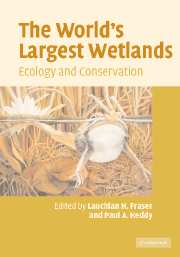Book contents
- Frontmatter
- Contents
- List of contributors
- Preface
- 1 Introduction: big is beautiful
- 2 The West Siberian Lowland
- 3 The Amazon River basin
- 4 The Hudson Bay Lowland
- 5 The Congo River basin
- 6 The Mackenzie River basin
- 7 The Pantanal
- 8 The Mississippi River alluvial plain
- 9 The Lake Chad basin
- 10 The River Nile basin
- 11 The prairie potholes of North America
- 12 The Magellanic moorland
- 13 The future of large wetlands: a global perspective
- Index
- References
9 - The Lake Chad basin
Published online by Cambridge University Press: 10 August 2009
- Frontmatter
- Contents
- List of contributors
- Preface
- 1 Introduction: big is beautiful
- 2 The West Siberian Lowland
- 3 The Amazon River basin
- 4 The Hudson Bay Lowland
- 5 The Congo River basin
- 6 The Mackenzie River basin
- 7 The Pantanal
- 8 The Mississippi River alluvial plain
- 9 The Lake Chad basin
- 10 The River Nile basin
- 11 The prairie potholes of North America
- 12 The Magellanic moorland
- 13 The future of large wetlands: a global perspective
- Index
- References
Summary
Introduction
The total area of wetlands in Africa has been estimated at 300 000 to 345 000 km2 (Balek 1977, Howard-Williams & Thompson 1985); while the World Resources Institute (2000) gives a somewhat overestimated value of more than 1 100 000 km2. Large wetlands are situated along the equator in the humid Congo–Zaire basin with 130 000 km2 of permanent or seasonally inundated forests and a number of large shallow lakes (Compère & Symoens 1987). These water bodies characterize a region with a humid climate and result from a fairly high and continuous direct rainfall. Wetland systems and floodplains may also be found in a semi-arid climate. In the West African Sahel, the semi-arid region south of the Sahara desert, the main wetland systems are those of the Chad basin and the Inner Delta of the River Niger in Mali (Fig. 9.1). They are fed mainly by streams originating in more-humid tropical regions that have a pronounced seasonality.
In a semi-arid climate, water is the limiting factor for the development of vegetation and the associated trophic webs. Wetlands or floodplains are thus a singularity in the landscape within an arid region: they are areas where water is much-less limiting than in the surroundings. The vegetation that may develop depends on the seasonality, duration, and depth of the inundation.
A number of classifications have been proposed for floodplains and wetlands.
- Type
- Chapter
- Information
- The World's Largest WetlandsEcology and Conservation, pp. 316 - 346Publisher: Cambridge University PressPrint publication year: 2005
References
- 1
- Cited by



